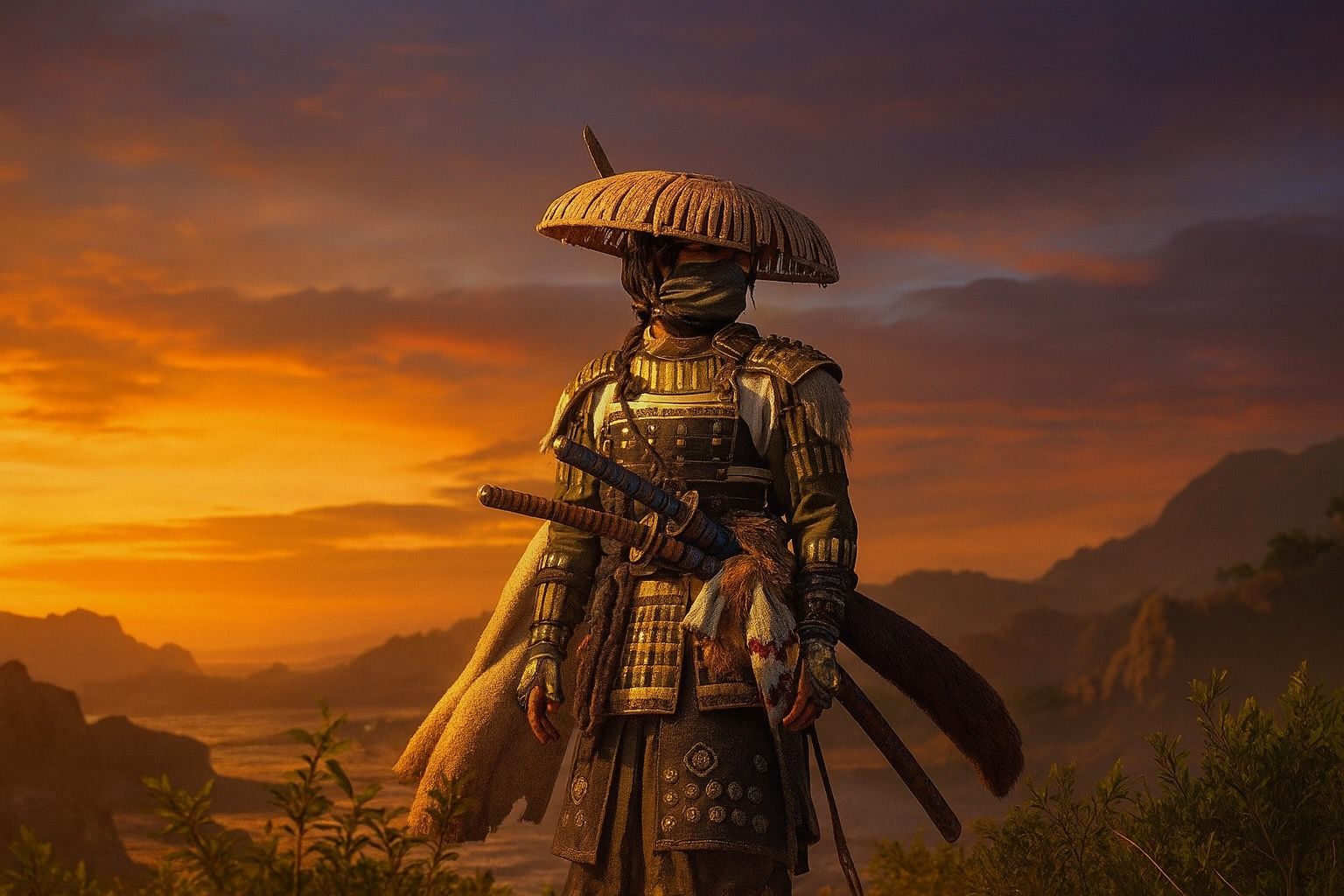- Release date and platform: Ghost of Yōtei launches 2 October 2025 exclusively on PlayStation 5, unlocking at midnight local time (9 p.m. PT/Oct 1 on the U.S. West Coast) [1]. The title is a standalone story separate from Ghost of Tsushima [2].
- Setting and premise: Set 300+ years after the events of Ghost of Tsushima, the story follows Atsu, a mercenary whose family were slaughtered by the Yōtei Six. She survived being pinned to a burning ginkgo tree and now returns with a kill list to avenge her family [3]. The game is set in Edo‑period Ezo (Hokkaido), featuring wild, beautiful landscapes and the ability to camp anywhere [4].
- Gameplay highlights: Players can tackle the Yōtei Six targets in any order, interrogate enemies and collect clues, and build a wolf‑pack of allies. Combat blends blades, spears and other melee weapons with firearms, yet emphasises swordplay [5]. Altars of Reflection grant skill points and hide in clever locations requiring platforming or solving environmental puzzles [6].
- Special features: Campfires serve as hubs where Atsu can rest, cook, craft gear, and recruit vendors; the DualSense touchpad lets players literally write names on Atsu’s kill list and cross them off after each assassination [7]. Players can play shamisen songs, build hot‑springs for healing, and participate in bamboo strikes.
- Critical reception: Early reviews hail the game as a refined, emotionally charged evolution of Ghost of Tsushima. Indy100 calls it a “game of the year contender” thanks to its sweeping vistas, deeper character moments and brutal yet cinematic combat [8]. Game Informer praises how writing names on the touchpad reinforces the revenge theme [9], while Kotaku notes the world evokes an American Western with stronger writing and an anti‑hero who feels more compelling than Jin [10].
- Controversy: The game’s hot‑spring sequences sparked debate; while some fans appreciate that the scenes mirror the original, others lament the lack of more revealing camera angles and the absence of Tsushima protagonist Jin [11]. Developers intentionally kept the sequence modest [12].
Overview and Release Details
Ghost of Yōtei is the next flagship open‑world adventure from Sucker Punch Productions and Sony Interactive Entertainment. Revealed in April 2025, the game arrives on 2 October 2025 for PlayStation 5, with players able to start from midnight local time (9 p.m. PT for the U.S. West Coast) [13]. This timing echoes the simultaneous worldwide launch of its predecessor. There is no confirmed PC release, though Ghost of Tsushima eventually appeared on PC; journalists speculate a similar delay [14].
Pre‑orders open 2 May 2025, with a $69.99/£69.99 standard edition. Digital Deluxe bundles include extra in‑game gear, while the lavish collector’s edition features a replica mask, tsuba, embroidered sash bearing the names of the Yōtei Six, a papercraft ginkgo tree and art cards [15]. A limited‑edition PS5 console and DualSense controller sporting game‑inspired designs accompany the release [16].
Story, Characters and Themes
Set during the early Edo period, the story begins with tragedy. Six warlords — The Snake, The Oni, The Kitsune, The Spider, The Dragon, and Lord Saitō — descend upon Atsu’s village, slaughtering her family and leaving her pinned to a burning ginkgo tree. She survives, learns combat arts for sixteen years, and returns to Ezo wielding the same katana that pierced her body. Her sole mission: cross every name off her list and avenge her family [17]. Each target has unique motivations and domains, from hidden temples to fortified compounds, making every confrontation narratively distinct and escalating the bounty on Atsu’s head [18].
Despite its revenge‑driven premise, the narrative promises nuance. Sucker Punch’s blog stresses that Atsu will “discover something more than revenge” as she travels the frontier, meeting unlikely allies and forging connections [19]. Game Informer notes the story is executed with surprising tenderness, seamlessly switching between present‑day hunts and flashbacks that explore Atsu’s childhood and relationship with her mother [20]. Reviewers highlight one mission targeting the Kitsune, praising how it blends mythology with personal introspection [21].
A More Complex Protagonist
Atsu differs from Tsushima’s Jin Sakai in both background and demeanor. She isn’t a samurai bound by honor but a mercenary who embraces any tactic to survive — from dual katanas to firearms and poisons [22]. Kotaku describes her as a “wandering outlaw” whose morally grey status makes her more compelling than Jin [23]. Her brashness and willingness to use dirty tricks set a tone closer to a Western anti‑hero than a noble samurai, giving the story a gritty edge.
The Yōtei Six and Revenge List
One of the game’s most distinctive mechanics is the kill list. Players can choose which Yōtei Six member to pursue first, collecting clues and interrogating enemies to locate them [24]. When a target is killed, players physically cross their name off the list using the DualSense touchpad, an immersive touch that reviewers found immensely satisfying [25]. Each kill increases the bounty on Atsu, sending tougher bounty hunters after her and heightening tension throughout the adventure [26].
World and Exploration
Setting: Ezo’s Untamed Beauty
The game’s open world expands to Hokkaido, an island seldom explored in mainstream games. Sucker Punch worked closely with cultural advisers to deliver a respectful portrayal of Edo‑period Japan [27]. The landscape includes snow‑capped peaks, golden foothills, volcanic craters, bamboo forests and windswept coastlines. Weather and time of day shift dynamically, and the minimal HUD returns, replaced by gusts of wind and animals guiding players to secrets — a design praised for encouraging organic exploration [28].
Players can pitch campfires anywhere, a new mechanic that acts as safe zones to cook meals, craft gear, learn new songs on the shamisen, recruit vendors and companions, and manage their kill list [29]. Campfires also serve as fast‑travel points. At large camps, Atsu can build shelters, hot springs, bamboo stations to increase health or resolve, and talk with her brother or other survivors to unlock side quests [30].
Altars of Reflection and Side Activities
Scattered across Ezo are Altars of Reflection, ancient monuments that grant precious skill points. To unlock abilities, players must find these altars — sometimes high atop towers, hidden behind camps or inside pits — and pay respects by bowing [31]. Some altars require solving environmental puzzles or using specific weapons; one altar near the Stone Spire Hideout asks players to climb a nearby tower, leap across trees, read a note instructing them to remain silent, and then play the shamisen to trigger a cutscene that lowers a ladder [32]. Others may involve clearing enemy camps or awakening a slumbering bear by playing music [33]. These challenges reward not only skill points but also immersive storytelling and breathtaking vistas.
In addition to altars, side content includes rescuing villagers, duels, bounty hunts, wind shrines, hot springs for reflection and health regeneration, bamboo strikes to practice precision, and building a wolf pack of allies who can accompany Atsu on missions [34]. Game Rant encourages players early on to explore Atsu’s homestead, rebuild stations, talk to civilians and samurai for tips, and help traders to unlock merchants [35].
Combat and Mechanics
Blades, Guns and Dirty Tricks
Combat in Ghost of Yōtei retains the cinematic elegance of its predecessor but layers in fresh tools. Atsu begins with a katana and gains access to dual blades, spears, long-handled odachi, kusarigama, bows, rifles, bombs and poisons [36]. Because she isn’t bound by samurai honor, she will hook foes, shoot them at range or finish them off with a poison jab. Foes can switch weapons mid‑battle, requiring on‑the‑fly adaptation. A spyglass helps players scout enemy camps, marking leaders and archers [37]. The return of Lethal Mode and new Miike and Watanabe camera filters allow players to tailor the cinematography, while 60 fps performance ensures fights feel fluid [38].
Indy100 lauds the combat as “brutal and cinematic,” highlighting how parries and counters look ripped from samurai films [39]. Game Informer calls the combat a ballet of attacks and counters, noting that switching between weapons mid‑fight feels seamless [40]. Players can choose stealthy takedowns, using tall grass to ambush enemies or chain assassinations, but should be prepared to face reinforcements as the bounty increases. The absence of loading screens keeps the pace relentless [41].
Wolf Den Challenges and Allies
New Wolf Den challenges let Atsu recruit animal companions and train them in combat techniques. As players build a wolf pack, they can call on wolves during missions to distract or attack enemies, adding tactical depth. Wolf‑type abilities unlock through completing Wolf Den challenges rather than through altars [42].
Atsu can also recruit human allies. Completing side quests for traveling sensei and helping villagers will add them to your camp or wolf pack. Each ally offers unique skills: an archer might provide covering fire, while a healer can restore health mid‑fight. Building relationships with these characters further humanises Atsu’s journey [43].
Hot‑Spring Debate and Fan Reactions
One surprising topic dominating early discussion is hot‑spring sequences. Carrying over from Ghost of Tsushima, these quiet interludes let players reflect on past events while bathing. In Yōtei, the camera lingers on Atsu’s backside but never shows her front, a modest approach that some fans appreciate. However, others on forums lament the lack of more revealing angles and miss the nude scenes featuring Jin Sakai from the previous game [44]. TheGamer reports that some fans joke about missing “Jin’s cake,” while others argue the community should move on [45]. The debate underscores ongoing tensions around sexualisation in games and the challenge of balancing fan expectations with respect for cultural settings and female characters.
Critical Reception and Expert Commentary
Early reviews suggest Ghost of Yōtei might be 2025’s stand‑out game. Indy100 calls it a top contender for game of the year, praising its stunning landscapes, refined mechanics and emotionally resonant story [46]. The review applauds the photo mode, minimal HUD and dynamic weather, noting that exploring Ezo feels like stepping into a living painting [47]. It highlights the range of cinematic modes — Samurai Cinema with Japanese audio, Kurosawa black‑and‑white, Miike close‑up and gritty Watanabe modes — and commends the 60 fps performance [48].
Game Informer awards the game a 9.25/10, arguing that the satisfaction of physically crossing off names on the DualSense touchpad is ingenious [49]. The reviewer notes that the revenge story, though familiar, is executed with precision and heart, thanks to flashbacks that humanise Atsu [50]. They also praise the side quests for enriching Atsu’s skills, the near‑instant load times, and the ability to bring vendors to camps to avoid backtracking [51].
Kotaku’s review‑in‑progress describes the game as an “impressive but familiar sequel,” noting that the world feels like an American Western with improved graphics. It applauds the stronger writing and says Atsu’s mercenary perspective adds freshness, though some tasks still feel like open‑world checklists [52]. GameSpot’s review emphasises that shifting from samurai to mercenary introduces “fresh ideas and improved mechanics,” with activities now tied to Atsu’s backstory and family [53].
The Washington Post (via meta description) summarises the game as an open‑world epic whose revenge story succeeds because it is written with precision and heart, and is anchored by a compelling lead performance [54].
Summary
Ghost of Yōtei offers a bold reinvention of Sucker Punch’s samurai formula. By shifting focus to a female mercenary and weaving a revenge tale that intersects with Edo‑period history, the game promises both spectacle and emotional depth. Players will explore the untamed beauty of Ezo, piece together clues, recruit allies and wolves, and cross names off a kill list — all while facing moral questions about revenge, justice and what it means to be an onryō. With its mixture of cinematic combat, environmental puzzles, robust side content and a protagonist who embraces dishonorable tactics, Ghost of Yōtei is poised to satisfy fans of Ghost of Tsushima while carving its own identity. The early critical acclaim and passionate debate about its features indicate it will dominate discussions when it releases in October 2025.
In summary, the report reveals that Ghost of Yōtei releases on 2 October 2025 exclusively for PlayStation 5. Set over 300 years after Ghost of Tsushima, it follows Atsu, a mercenary seeking vengeance against the Yōtei Six after surviving a brutal massacre [55]. The game introduces a kill-list mechanic utilizing the DualSense touchpad, letting players literally cross off names as targets are eliminated, and offers a richly detailed Edo-period Hokkaido world filled with altars, hot springs, and dynamic weather [56]. Early reviews praise its narrative depth, stunning visuals, and refined combat, positioning it as a potential game of the year contender [57].
References
1. www.gamespot.com, 2. www.gamespot.com, 3. blog.playstation.com, 4. www.gamesradar.com, 5. www.gamesradar.com, 6. www.gamespot.com, 7. gameinformer.com, 8. www.indy100.com, 9. gameinformer.com, 10. kotaku.com, 11. opencritic.com, 12. www.thegamer.com, 13. www.gamespot.com, 14. www.gamesradar.com, 15. blog.playstation.com, 16. www.gamesradar.com, 17. blog.playstation.com, 18. www.gamesradar.com, 19. blog.playstation.com, 20. gameinformer.com, 21. gameinformer.com, 22. www.gamesradar.com, 23. kotaku.com, 24. www.gamesradar.com, 25. gameinformer.com, 26. www.gamesradar.com, 27. www.gamesradar.com, 28. www.indy100.com, 29. www.gamesradar.com, 30. gamerant.com, 31. www.gamespot.com, 32. www.thegamer.com, 33. www.gamespot.com, 34. www.gamesradar.com, 35. gamerant.com, 36. www.gamesradar.com, 37. www.gamesradar.com, 38. www.indy100.com, 39. www.indy100.com, 40. gameinformer.com, 41. gameinformer.com, 42. www.gamespot.com, 43. www.gamesradar.com, 44. opencritic.com, 45. www.thegamer.com, 46. www.indy100.com, 47. www.indy100.com, 48. www.indy100.com, 49. gameinformer.com, 50. gameinformer.com, 51. gameinformer.com, 52. kotaku.com, 53. www.gamespot.com, 54. www.washingtonpost.com, 55. blog.playstation.com, 56. gameinformer.com, 57. www.indy100.com










